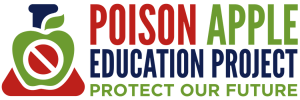- thebmj/The British Medical Journal – prenatal and infant exposure to ambient pestidices and autism spectrum disorder in children: Population based case-control study. 06/25/2019
https://www.bmj.com/content/364/bmj.l962
Info: Findings suggest that an offspring’s risk of autism spectrum disorder increases following prenatal exposure to ambient pesticides within 2000 m of their mother’s residence during pregnancy, compared with offspring of women from the same agricultural region without such exposure. Infant exposure could further increase risks for autism spectrum disorder with comorbid intellectual disability.
Harvard T.H. Chan: School of Public Health – Pesticides tied to ADHD in children 07/2010
https://www.hsph.harvard.edu/news/multimedia-article/adhdpesticide/
Provides links to 2 articles:
- “ADHD in kids tied to Organophosphate Pesticides – coverage from Ruesters.”
- http://www.reuters.com/article/idUSTRE64G41R20100517
- “Study links pesticides to ADHD in children” – coverage from the Los Angeles Times
- http://articles.latimes.com/2010/may/16/science/la-sci-pesticides-20100517
PNAS/Proceedings of the National Academy of Sciences of the United States – Maternal glyphosate exposure causes autism like behaviors in offspring through increased exposure soluble epoxide hydrolase. 05/12/2020.
https://www.pnas.org/doi/10.1073/pnas.1922287117
Info: Collectively, these findings suggest that the sEH enzyme plays a key role in the development of ASD-like behavioral abnormalities in offspring after maternal glyphosate exposure, and that sEH inhibitors may prove to be promising prophylactic or therapeutic drugs for ASD.
CHADD – Pesticides could play a role for some people with ADHD. 9/6/2019
https://chadd.org/adhd-weekly/pesticides-could-play-a-role-for-some-people-with-adhd/
Info: The evidence shows pesticides and insecticides may play a role in developing ADHD for some people. Researchers have not yet identified the exact role or relationship and encourage additional studies. It appears that women who are hoping to have children or are pregnant should be cautious in their food choices to minimize their exposure to pesticides and insecticides, opting for organic foods if they are able. Parents may also want to choose organic foods or foods raised with minimal use of pesticides and insecticides for their children when possible.
University of California of Davis – Maternal exposure to farm pesticides linked to autism in offspring. 06/23/2014
Info: “This study validates the results of earlier research that has reported associations between having a child with autism and prenatal exposure to agricultural chemicals in California,” said lead study author Janie F. Shelton, a UC Davis graduate student who now consults with the United Nations. “While we still must investigate whether certain sub-groups are more vulnerable to exposures to these compounds than others, the message is very clear: Women who are pregnant should take special care to avoid contact with agricultural chemicals whenever possible.”
YALE NEWS – Prevalence of Autism in South Korea estimated at 1 in 38 children. 05/09/2011
https://news.yale.edu/2011/05/09/prevalence-autism-south-korea-estimated-1-38-children
CNN – Common weed killer glyphosate increases cancer risk by 41%. 02/15/2019
https://www.cnn.com/2019/02/14/health/us-glyphosate-cancer-study-scli-intl/index.html
CTV NEWS – Birth defects, cancer in Argentina linked to agrochemicals: AP Investigation. 10/20/2013.
National Library of Medicine – Agricultural development, Pesticide Application, and It’s Impact on the Environment. 01/27/2021
https://www.ncbi.nlm.nih.gov/pmc/articles/PMC7908628/
Info: Therefore, there is necessary to control pesticide contamination and its negative influence on environmental and other non-target organisms. Further studies should focus on both occupational and environmental exposures and their related health risk assessment of pesticides to better understand pesticide use and management in the future. To minimize the negative influence of pesticide contamination on the environment and non-target organisms, new scientific methodology and technology and useful measures, such as integrated pest management (IPM), laws that forbid pesticides with high risks, and the development of a national implementation plan (NIP), should be implemented, to reduce the negative effects of pesticides. Furthermore, it is crucial to convey the scientific outcomes of the exposure and occupational and environmental health risk assessments to provide scientific training for pesticide application, the prevention of adverse health effects of pesticide usage, and the promotion of safety for applicators and communities to support sustainable development. Biopesticides should also be developed alongside chemical pesticides to minimize pesticide contamination.
School of Public Health/University of Michigan – Toxic Substance Control Act and the Regulation of Chemicals. 03/16/2021
https://sph.umich.edu/news/2021posts/toxic-substances-control-act-chemical-regulation.html
Info: The science has advanced regarding how industrial chemicals and environmental pollutants can adversely influence people’s health, but EPA methods for evaluating the evidence to use in policy decision-making has not kept pace with this science. For many chemicals, there is well-supported evidence showing there are health risks from common everyday exposures to factors that amplify the risks such as background exposures to multiple pollutants, preexisting disease, intrinsic factors like genetics, social vulnerabilities, and susceptible life stages such as when children develop or people age.
Autism Parenting Magazine – Autism Statistics You Need To Know in 2024. 01/16/2024
https://www.autismparentingmagazine.com/autism-statistics/
Info: The latest research in 2023 from the CDC shows that one in 36 children is now diagnosed with autism. Some areas have higher than average prevalence rates: California 1/26 & South Korea 1/38.
ProPublica – Why the U.S. Is Losing the Fight to Ban Toxic Chemicals. 12/14/2022
Info: “From a powerful chemical industry that helped write the toxic substances law to an underfunded EPA lacking in resolve, the flaws in the American chemical regulatory apparatus run deep.”

